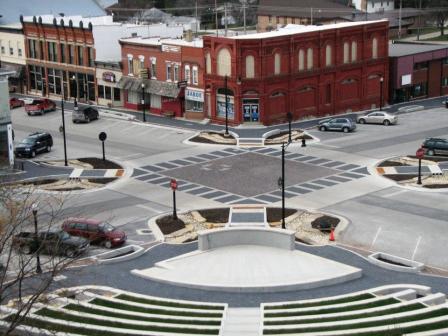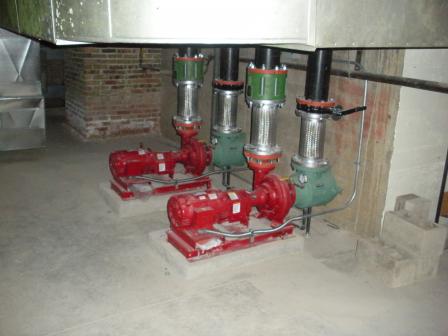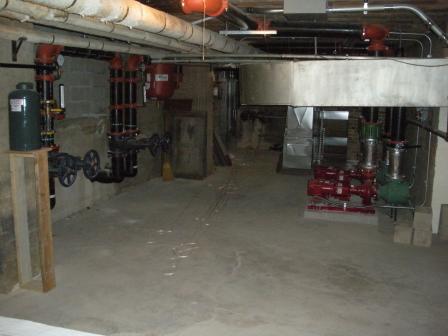West Union Green Downtown
Learn about other climate showcase communities.
West Union, Iowa
Federal Funding: $500,000
Project Timeline: October 2010 – November 2012
- Project Summary
- Community Characteristics
- Results
- Lessons Learned
- Sustainability/ Replication
- Project Websites
- Photos
To reduce greenhouse gas (GHG) emissions and replace aging downtown infrastructure, West Union, Iowa installed a geothermal heating and cooling district in six downtown blocks and renovated the area with environmentally-friendly infrastructure. The project was part of the community's Clean Green Climate Action Plan. The National Renewable Energy Laboratory provided input for the project, and green best practices were integrated into the project. The project conserved energy, reduced GHG emissions, and improved downtown pedestrian infrastructure.
The key component of West Union's Clean Green Climate Action Plan was the implementation of a geothermal heating and cooling system for six blocks of the downtown area, including a radiant-heat snow melt system for the streetscape. A new city-owned utility will oversee the system, which will heat and cool the County Courthouse as well as residences and businesses in the 60 buildings that lie within the district. These buildings represent 330,000 square feet of conditioned space, and the system could provide heating and cooling for 80% of this space.
Construction of the West Union green streetscape has been completed. West Union additionally completed building water and sewer infrastructure for the project, including a new porous paving system. All 130 geothermal wells in Courthouse Square have been completed. Pump house and landscape construction is complete, and the entire streetscape project was finished by its grand opening celebration in July 2013.
In addition, a green streetscape including rainwater harvesting systems, porous pavement, and rain gardens was installed, along with energy-efficient street lighting. Bike racks and pedestrian infrastructure improvements also helped encourage biking and walking.
The project reduced GHG emissions by providing a lower emissions source of energy to offset conventional energy use. In addition, more residents were able to bike downtown, reducing the use of motorized transportation.
Population: 2,550
Area: 2.7 square miles
Government Type: City
Community Type: Rural
Median Household Income: $34,515
|
Final Results |
Projected Cumulative Results |
|
|---|---|---|
|
Annual GHG Reductions |
80 mt CO2e |
320 mt CO2e |
- One of the main challenges faced with this project is the use of funds and compliance with the different funding sources. There were three federal agencies, six state agencies and a number of local funding sources used in this comprehensive project. This created some difficulties as the City was looking at the project comprehensively, and some funding sources only wanted to see the portion of the project their funding went to. It required a lot of communication between the City and all parties involved to make sure everything was documented as it needed to be.
- Another challenge faced was educating and communication with the citizens of West Union throughout the project. With this innovative and complex project happening in such a small town, it was essential that everyone understood and supported the work that was being done.
- It helped to have the local newspaper in support of the project; they published weekly updates. This helped reach a many residents and kept everyone engaged in the project. The streetscape project and any expenses, contracts, or major decisions were also discussed at every council meeting. This left the public with ample opportunity to have any questions answered.
- Two local banks have unveiled an energy efficiency and facade improvement financial assistance program, making funding available at 0.75 percent above the prime lending rate for a period of five years, after which any remaining balance can be refinanced at prevailing rates.
- The storm water management portion of the overall project was integral in decreasing storm water runoff. Porous pavers now allow storm water to infiltrate through, cleansing and cooling the water prior to its eventual discharge into Otter Creek. The City will continue to monitor the positive impact of this system over the next two years.
- The entire geothermal infrastructure has been installed. The City contracted with FVB Energy, Minneapolis Minnesota, to provide analysis of the geothermal system. This analysis provided the fair market value of the infrastructure required to lease the system to the LLC as well as provide detailed rate analysis. The final report was released in 2013. This piece of information is vital to replication of the district system. Many states do not have laws regarding the specifics of how a district geothermal system can operate through a lease structure. The City of West Union is a pioneer in this area. They will be able to provide a detailed "road map" of how to set up a similar structure throughout the country.
West Union: Green Pilot Community Project Overview Exit
 Courthouse Roof View
Courthouse Roof View Pumps
Pumps Pumps
Pumps